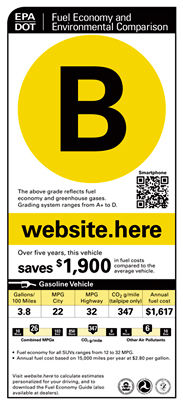Reading the news in our automotive world never fails to surprise and delight.
Take, for example, our discovery of the soliticitousness exhibited by automakers who care deeply about the delicate and fragile feelings of car buyers.
Yes, those same car buyers from whom an independent dealer's job is extract maximum profits on the sale of a vehicle, one whose invoice cost and incentives are now more or less public knowledge.
The issue that so threatens the self-esteem of delicate drivers is one of two designs for new-car fuel efficiency ratings stickers proposed two weeks ago by the U.S. Environmental Protection Agency.

Proposed design (1 of 2) for gas mileage and emissions impact of new vehicle, U.S. EPA, August 2010
Back in April, the National Auto Dealers' Association criticized new fuel-efficiency rules for 2012-2016 vehicles, well before the proposed window stickers were made public, noting that three agencies had contributed to the (uniform) set of standards that emerged for the 2012-2016 model years.
In a statement, NADA said that the price of new cars and trucks would rise "significantly" under the tighter rules. Given economic uncertainties, said the voice of the nation's auto dealers, consumers do not want to "pay more for redundant rules and an unnecessary bureaucracy."
The Association left unexplained why an agency charged by Congress with protecting environmental quality, including regulation of vehicle emissions, constituted an "unnecessary bureaucracy." But then, bashing government workers always plays well.
Now, Dave McCurdy, president and CEO of the Auto Alliance (which represents automakers that manufacture in the States other than GM, Ford, and Chrysler), has gone further. He is deeply concerned about the proposed window sticker design. Why?
"The proposed letter grade falls short," McCurdy said, "because it is imbued with school-yard memories of passing and failing."
How awful. How challenging. How downright traumatizing and dreadful. Imagine: Some cars might pass, while others might ... [gasp] ... fail.
Perhaps every potential car buyer should get a nice bright shiny sticker, just for participating! That way, none of us would feel scorned, or bullied, or less-than-better-than-average. Happy smiley faces all around!
In reality, of course, we suspect the reason the industry dislikes the letter grades is because they would spotlight which vehicles--across the entire spectrum of vehicles for sale--have good fuel economy, and which don't.
Sadly, at the moment, most of the highly fuel efficient vehicles that would win As or Bs are smaller--and less profitable for manufacturers and dealers--than the larger, luxury-laden full-size cars and trucks that would be awarded the Cs and Ds.
Could it be that some car buyers on the margin might tilt toward a smaller, more fuel-efficient car? How dreadful that would be.
We rather wish that executives would just come out and say that letter grades might reduce industry profits by driving consumers toward more fuel-efficient vehicles.
Because, call us cynical if you will, but we just don't believe that the auto industry really, truly cares about the delicate state of our psyches. Or our school-yard memories.












